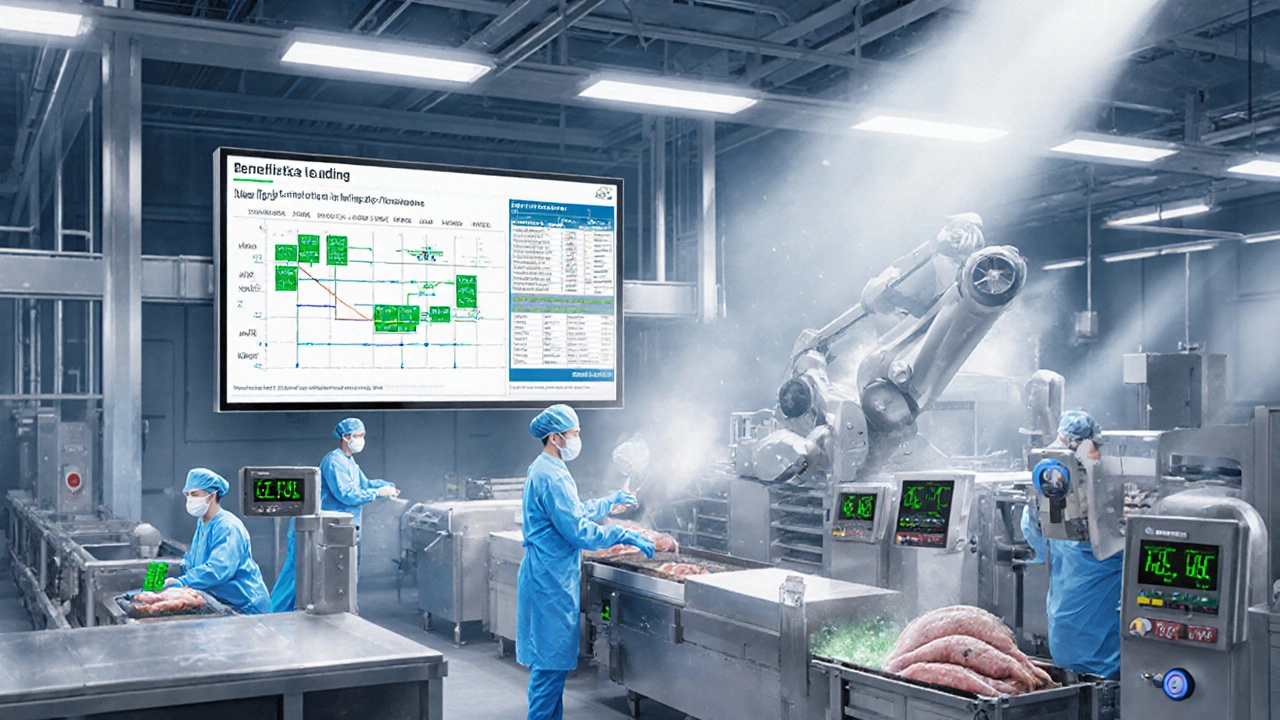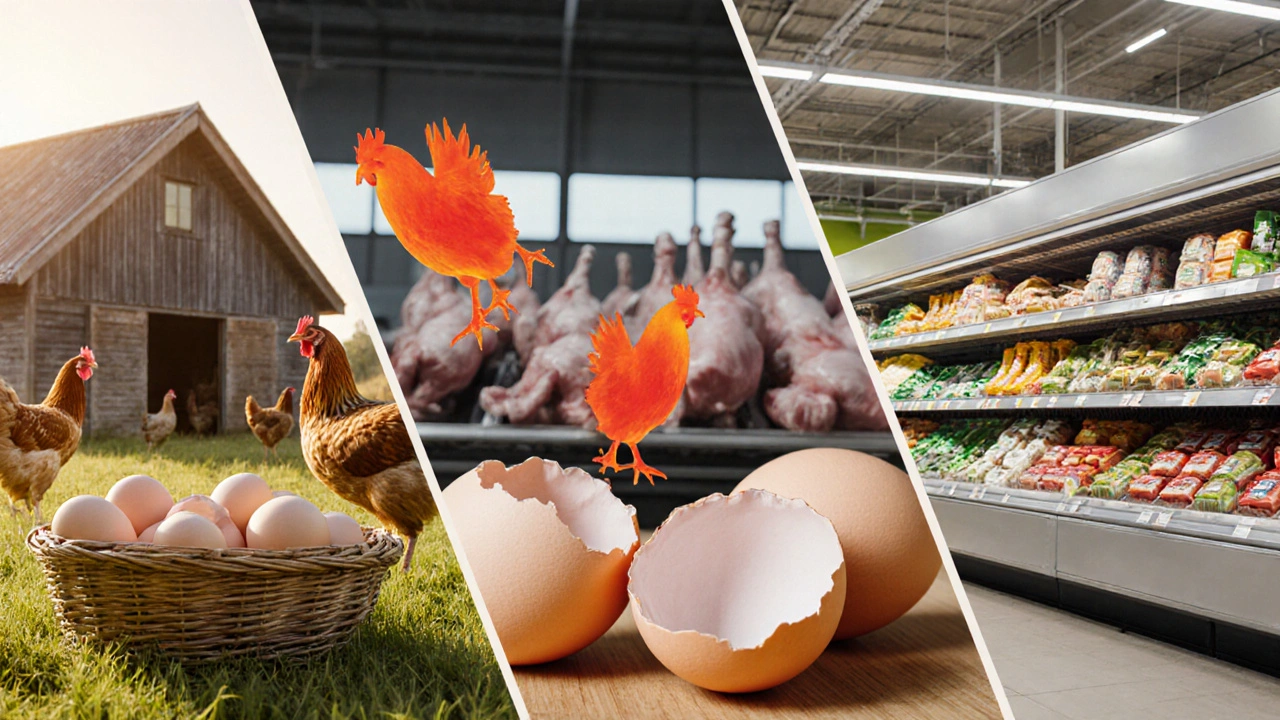Salmonella Growth Calculator
Enter the temperature and time to see how salmonella growth risk changes. The calculator uses scientific data on bacterial growth rates and is based on industry standards discussed in the article.
Salmonella Growth Risk Analysis
Temperature: °C
Exposure Time: hours
Estimated Bacterial Growth:
Why This Matters
Salmonella multiplies rapidly between 5°C and 45°C, with peak growth at 37°C. The Food Standards Agency notes that maintaining temperatures below 5°C or above 60°C significantly reduces risk, while temperatures in the danger zone (5-45°C) allow bacteria to double every 20 minutes. This tool helps visualize how temperature control prevents salmonellosis.
Key Takeaways
- Salmonellosis causes an estimated 100,000 UK cases each year and can be traced to lapses in food handling.
- The food industry’s biggest leverage points are strict hygiene, temperature control, and supplier verification.
- Implementing HACCP, routine sanitisation, and robust traceability cuts outbreak risk by up to 70%.
- Regulatory bodies such as the Food Standards Agency set enforceable standards that every processor must meet.
- A simple 10‑step checklist helps businesses stay ahead of contamination and protect consumers.
Salmonellosis still shows up on headlines despite decades of food‑safety work. In the UK alone, the Health Security Agency records roughly 100,000 confirmed cases each year, many linked to eggs, poultry, or fresh produce. The culprit? Salmonellosis is a bacterial infection caused by Salmonella that leads to fever, diarrhoea, and sometimes severe dehydration. While individuals can protect themselves at home, the biggest barrier to infection sits high up the supply chain - the food industry is the network of producers, processors, distributors, and retailers that moves food from farm to fork. This article breaks down how the industry can keep salmonella out of the products you buy, the regulations that drive change, and practical steps every business can follow.
Understanding Salmonellosis and Its Impact
When Salmonellosis enters the body, the bacteria invade the intestinal lining, multiply, and trigger an immune response. Symptoms appear within 6‑72hours and usually last 4‑7days. Vulnerable groups - children, the elderly, and immunocompromised patients - face higher hospitalisation rates. In 2023, UK hospitals logged over 1,200 admissions linked to salmonella, costing the NHS roughly £15million in treatment and lost productivity.
Why does the disease keep resurfacing? Much of the risk stems from cross‑contamination during processing, inadequate cooking temperatures, and poor storage. By targeting these weak spots, the food industry can slash the number of cases dramatically.
Why the Food Industry Matters
The Food Industry controls the environment where pathogens thrive. From hatcheries to retail shelves, each step offers an opportunity to either amplify or eliminate salmonella. For example, a single contaminated egg batch can expose millions of consumers if not caught early. Conversely, a robust safety culture can stop the bacterium before it ever reaches the consumer.
Key players include primary producers (farmers, hatcheries), processors (slaughterhouses, egg‑packing plants), distributors, and retailers. Each must adopt Food Safety measures that align with legal standards and consumer expectations.

Core Prevention Strategies
Modern food safety rests on three pillars: hygiene, monitoring, and verification.
1. HACCP - The Blueprint for Safe Production
The HACCP (Hazard Analysis and Critical Control Points) framework forces businesses to identify where salmonella could enter a product and set limits to keep it out. Typical critical control points (CCPs) for poultry include:
- Incoming raw material testing for Salmonella presence.
- Scalding water temperature (≥55°C) to kill surface bacteria.
- Chilling within 2hours of slaughter to stop bacterial growth.
When a CCP is breached, HACCP mandates immediate corrective actions, documentation, and review to prevent recurrence.
2. Temperature Control - The First Line of Defense
Salmonella multiplies quickly between 5°C and 45°C, with a peak at 37°C. Temperature Control therefore means:
- Keeping cold foods at ≤4°C from farm to retail.
- Cooking hot foods to internal temperatures of ≥75°C (eggs 70°C, chicken 78°C).
- Using validated cooling curves - dropping from 60°C to 21°C within 2hours, then to 5°C within a further 4hours.
Data loggers and real‑time alerts help processors stay within these windows, reducing bacterial growth risk by up to 60%.
3. Sanitisation - Killing the Invisible Enemy
Surface hygiene is non‑negotiable. Sanitisation protocols typically combine:
- Mechanical cleaning to remove organic matter.
- Approved chemical agents (e.g., peracetic acid at 200ppm) with validated contact times.
- Routine microbiological swabs to verify efficacy.
Facilities that perform daily sanitisation of equipment, conveyors, and cutting boards see a 45% drop in positive salmonella samples.
4. Supplier Verification & Traceability
Even the best in‑house controls falter if raw ingredients arrive already contaminated. Auditing suppliers, demanding third‑party certifications, and maintaining a digital traceability ledger allow rapid product recalls. In a 2022 UK egg outbreak, companies that could pinpoint batches within 48hours contained the spread far better than those lacking traceability.
5. Employee Training & Culture
Human error remains the top cause of breaches. Regular, hands‑on training on glove use, hand‑washing, and proper equipment handling builds a safety‑first mindset. Studies by the Food Standards Agency show that facilities with certified food‑handler programs experience 30% fewer hygiene violations.
Pre‑harvest vs Post‑harvest Controls - A Quick Comparison
| Aspect | Pre‑harvest (Farm) | Post‑harvest (Processing) |
|---|---|---|
| Primary Goal | Reduce colonisation in live animals | Eliminate residual bacteria on carcasses |
| Key Measures | Vaccination, probiotic feed, biosecurity | Scalding, chilling, HACCP monitoring |
| Typical Testing | Fecal swabs, environmental samples | Product rinse testing, surface swabs |
| Regulatory Oversight | Animal Health Act, EU Animal Health Rules | Food Hygiene Regulations, FSMA equivalents |
| Impact on Outbreak Risk | Reduces initial load by 40‑60% | Final kill step cuts residual by 90% |
Regulations That Drive Safer Food
In the UK, the Food Standards Agency (FSA) enforces the Food Safety Act 1990, the Hygiene of Food Regulations 2006, and the EU‑derived Regulation (EC) No2073/2005 on microbiological criteria. These statutes require:
- Routine testing for Salmonella in high‑risk foods such as eggs, poultry, and ready‑to‑eat meals.
- Documentation of HACCP plans and verification records for at least 24months.
- Immediate notification of any confirmed contamination to local authorities.
Non‑compliance triggers inspections, mandatory product withdrawals, and hefty fines-up to £50,000 for severe breaches.

Practical Checklist for Food Businesses
Below is a 10‑step checklist that any food‑handling operation can adopt today:
- Develop a written HACCP plan with at least three critical control points for salmonella.
- Validate temperature controls using calibrated data loggers on all storage units.
- Schedule daily sanitisation cycles with documented chemical concentrations and contact times.
- Implement a supplier audit program; require certificates of analysis for raw egg and poultry deliveries.
- Conduct weekly microbiological swabs on equipment and record results.
- Train all staff on proper hand‑washing, glove changes, and cross‑contamination avoidance.
- Maintain a digital traceability system that links lot numbers to supplier batches.
- Review and update the HACCP plan after any corrective action or new product launch.
- Perform mock recalls quarterly to test response speed and communication clarity.
- Engage with the Food Standards Agency for guidance on emerging risks and regulation updates.
Common Pitfalls and How to Avoid Them
Pitfall 1: Relying on end‑product testing alone. Testing after processing catches some failures but cannot replace upstream controls. Solution: Integrate sampling at the farm, during transport, and at multiple processing stages.
Pitfall 2: Inconsistent record‑keeping. Gaps in documentation make audits painful and hinder root‑cause analysis. Solution: Use electronic batch record software that timestamps every entry.
Pitfall 3: Under‑estimating employee turnover. New staff may miss critical steps. Solution: Pair formal training with on‑the‑job mentorship for at least the first two weeks.
Looking Ahead: Emerging Tools
Rapid PCR kits now detect Salmonella on-site within 30minutes, letting processors intervene before a batch moves forward. Likewise, AI‑driven predictive models analyse temperature logs and flag deviations before they become hazards. Early adopters report up to a 25% reduction in outbreak incidents.
Frequently Asked Questions
How long does salmonella survive on kitchen surfaces?
On dry, non‑porous surfaces, salmonella can survive for weeks if not cleaned properly. Moist environments, like cutting boards left wet, extend survival even further, making regular sanitisation essential.
What temperature kills salmonella in eggs?
Cooking eggs until the yolk and white reach at least 70°C (158°F) reliably destroys salmonella. For baked dishes, an internal temperature of 75°C (167°F) is recommended.
Can frozen poultry still carry salmonella?
Freezing does not kill salmonella; it merely halts its growth. Thawing must be done under controlled, refrigerated conditions to prevent bacterial multiplication.
What are the legal limits for salmonella in ready‑to‑eat foods in the UK?
Regulation (EC) No2073/2005 sets a limit of 0CFU/g for Salmonella spp. in ready‑to‑eat foods. Any detection triggers mandatory product withdrawal.
How often should a food business audit its suppliers?
Best practice is an annual full audit, with spot checks quarterly for high‑risk ingredients like eggs and poultry. Any change in supplier or ingredient source warrants an immediate review.


Allan Jovero
October 12, 2025 AT 01:58The implementation of HACCP protocols constitutes the cornerstone of any robust salmonella mitigation strategy; it delineates critical control points with unambiguous limits and mandates immediate corrective actions upon deviation, thereby ensuring systematic risk reduction across the production continuum.
Andy V
October 19, 2025 AT 17:29It is utterly unacceptable that many facilities still rely on end‑product testing alone; such an approach disregards upstream controls and invites preventable contamination, which must be eradicated without delay.
Tammie Sinnott
October 27, 2025 AT 08:01Listen up, because the facts about salmonella are both fascinating and terrifying. First, the bacterium thrives in the classic "danger zone" between five and forty‑five degrees Celsius, doubling its population roughly every twenty minutes at optimal warmth. Second, temperature control isn’t just a suggestion-it’s a legal requirement enforced by the Food Standards Agency and backed by decades of scientific evidence. Third, modern data loggers now provide real‑time alerts, so any breach can be corrected before the bacteria get a foothold. Fourth, sanitation regimes that combine mechanical scrubbing with peracetic acid have been shown to slash positive samples by nearly half. Fifth, supplier verification isn’t a bureaucratic nuisance; auditors who demand certificates of analysis for eggs and poultry prevent contaminated batches from ever entering the line. Sixth, the cost of an outbreak-millions in medical expenses and lost productivity-far outweighs the modest investment in robust HACCP documentation. Seventh, rapid PCR kits now detect salmonella on‑site within thirty minutes, allowing immediate quarantine of suspect lots. Eighth, AI‑driven predictive models can forecast temperature excursions before they happen, offering a proactive shield against microbial growth. Ninth, employee turnover remains a hidden hazard; consistent training and mentorship dramatically lower hygiene violations. Tenth, traceability systems that link each product to its source batch enable recalls within forty‑eight hours, a crucial factor in limiting public exposure. Eleventh, freezing does not kill salmonella, merely pauses its activity, so thawing protocols must be rigorously controlled. Twelfth, the legal limit for ready‑to‑eat foods in the UK is zero colony‑forming units per gram-any detection triggers mandatory withdrawal. Thirteenth, cross‑contamination can occur on seemingly innocuous surfaces like cutting boards left damp, underscoring the importance of regular sanitisation. Fourteenth, the most effective mitigation combines pre‑harvest vaccinations with post‑harvest scalding temperatures of at least fifty‑five degrees Celsius. Fifteenth, consumer education about proper cooking temperatures (seventy degrees Celsius for eggs, seventy‑eight for chicken) remains vital. Finally, continuous improvement-reviewing corrective actions, updating HACCP plans, and embracing emerging technologies-ensures the food industry stays ahead of salmonella’s relentless evolution.
Michelle Wigdorovitz
November 3, 2025 AT 23:33Just saw the risk calculator and it really drives home how quickly things can go south if the cold chain slips; those visual cues are gold for anyone in the kitchen.
Arianne Gatchalian
November 11, 2025 AT 15:05I totally agree with the emphasis on regular microbiological swabs; keeping a collaborative log helps the whole team stay on the same page and feel confident about safety.
Aly Neumeister
November 19, 2025 AT 06:36While the long list of steps is thorough, the real challenge lies in sustaining daily discipline; a slight slip can undo weeks of effort.
joni darmawan
November 26, 2025 AT 22:08Indeed, the philosophical underpinning of continuous vigilance reminds us that food safety is not a destination but an ongoing journey, wherein each procedural nuance contributes to the collective well‑being.
Richard Gerhart
December 4, 2025 AT 13:40Hey man, love the point on data loggers-i've seen a few places where that tech saved them from a huge loss, real game changer.
Kim M
December 12, 2025 AT 05:12They’re hiding the truth about the chemicals they add 😱